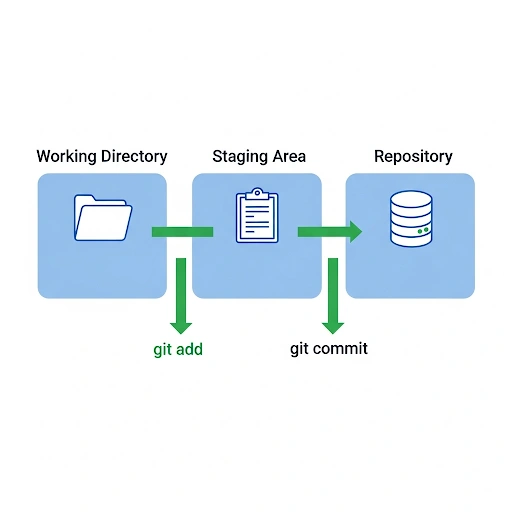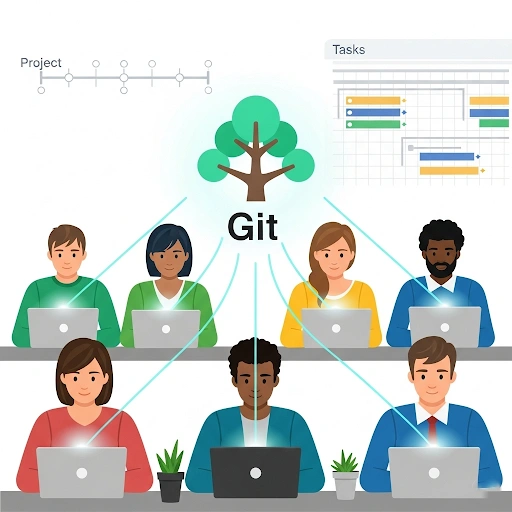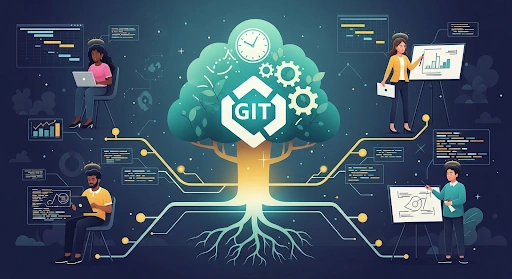Ever saved a file as “Final_Report_v2_final_I_PROMISE.docx”? There’s a better way that reflects strategic time management in action. By treating version control as a tool for smarter work, you practice strategic time management without even noticing it. This simple shift is a core part of strategic time management that helps you stay focused. With Git, you gain the benefits of strategic time management while keeping every version of your work safe.
Whether you’re a writer, a designer, a developer, or anyone creating digital work, you’ve faced that moment of panic. You delete a crucial paragraph, overwrite an important file, or realize a “small change” has broken everything. This is where strategic time management becomes vital, giving you the structure to recover quickly. You desperately wish for an “undo” button, and version control delivers exactly that through strategic time management practices. Git, the most powerful tool here, shows how strategic time management is more than planning—it’s protection. This guide to Git for beginners reveals how strategic time management saves time, prevents disasters, and transforms the way you work.
- What is Version Control, Anyway? A Guide to Strategic Time Management in Development
- Why You Can’t Afford to Ignore Version Control
- The Core Concepts: How Git Thinks
- Let’s Use Git: A Writer’s Workflow
- Git vs. Other Methods (The “Old Way”)
- Common Mistakes for Beginners to Avoid
- Expert Tips for Getting Started
- Frequently Asked Questions (FAQ)
- Conclusion: Your Journey with Git Starts Now
What is Version Control, Anyway? A Guide to Strategic Time Management in Development
In the simplest terms, a Version Control System (VCS) is a tool that tracks changes to a file or set of files over time. It works like a detailed logbook for your project and supports strategic time management by organizing every step. Instead of saving multiple, confusingly named copies, you keep one project where strategic time management ensures order and clarity. The VCS records a snapshot each time you update, showing how strategic time management helps compare versions efficiently. This way, you can recall past work, measure changes, or revert a project—clear proof that strategic time management keeps everything under control.
In 2025, in an era of collaborative, remote work, version control is indispensable. It’s the backbone of modern software development, but its applications are spreading to every field that involves digital creation. The trend is moving towards making these tools more accessible and integrated into everyday applications. To learn Git basics is to learn the language of modern collaboration and project safety.

Why You Can’t Afford to Ignore Version Control
Adopting Git might seem like a technical hurdle, but the benefits are immediate and profound, transforming your workflow from fragile to robust.
Create a Safety Net for Your Work
Git is your project’s ultimate undo button. Did you delete a file by accident? Did a recent change introduce a major error? With Git, you can simply rewind to the last working version. This freedom from fear allows you to experiment and innovate without the risk of permanently damaging your project.
Understand the History of Your Project
A well-maintained Git repository tells the story of your project. You can see who made what change, when they made it, and why they made it (via commit messages). This complete history is invaluable for debugging, understanding past decisions, and onboarding new team members.
Collaborate Seamlessly with a Team
This is where Git truly shines. It allows multiple people to work on the same project simultaneously without overwriting each other’s work. Git helps you merge these changes together intelligently, highlighting conflicts when two people have edited the same line. This is a skill as crucial as learning professional negotiation techniques for teamwork.
The Core Concepts: How Git Thinks
To learn Git, you need to understand a few key ideas. Let’s break down the most important ones.
The Repository (Repo)
This is the heart of your project. A repository is a folder that contains all your project files and the entire history of their changes, stored in a hidden sub-folder called .git.
The Three Stages: Working, Staging, and Committing
This is the fundamental workflow in Git. It’s like preparing a package for shipping.
- Working Directory: This is your project folder where you actively edit your files. It’s your messy workshop.
- Staging Area: This is a preparation area. When you’ve made a change you want to save, you add it to the staging area. This is like putting an item in the shipping box.
- Repository (.git directory): When you’re happy with the contents of your staging area, you “commit” them. This takes a permanent snapshot of the staged files and saves it to your project history with a descriptive message. This is like sealing the box and putting a label on it.

Branches: Experimenting Safely
Imagine your project has a main timeline (called the `main` or `master` branch). A branch is essentially a copy of this timeline. It allows you to diverge from the main line of work to develop a new feature, fix a bug, or just experiment, without affecting the stable, main version. Once you’re happy with your changes on the branch, you can merge them back into the main timeline.
Let’s Use Git: A Writer’s Workflow
Let’s see how a freelance writer, Alex, uses Git to manage a blog post.
1. Initialization
Alex creates a new folder for the article and initializes a Git repository inside it using the command line.
git init2. First Draft and Commit
Alex writes the first draft in a file called `article.md`. After finishing, Alex stages and commits the file.
# Add the file to the staging area
git add article.md
# Commit the staged file with a message
git commit -m "Write first draft of the article"3. Creating a Branch for Edits
An editor suggests a major rewrite of the introduction. Instead of editing the main file directly, Alex creates a new branch to work on the changes safely.
# Create a new branch and switch to it
git checkout -b rewrite-introductionNow, any changes made will only affect this `rewrite-introduction` branch.
4. Merging the Changes
After rewriting the intro and committing the changes on the branch, Alex is happy with it and merges it back into the main timeline.
# Switch back to the main branch
git checkout main
# Merge the changes from the other branch into main
git merge rewrite-introductionThe main article is now updated with the new introduction, and the project’s history clearly shows where this change came from.
Git vs. Other Methods (The “Old Way”)
| Feature | Git & Version Control | Manual File Copying |
|---|---|---|
| History | Detailed, chronological log of every change with author and message. | Chaotic. Relies on file names like `report_v3_final.doc`. |
| Collaboration | Structured merging of work from multiple people. | “Who has the latest version?” Constantly overwriting each other’s work. |
| Storage | Efficient. Only stores the differences between files, not full copies. | Highly inefficient. Creates full duplicate copies of the project for each version. |
Common Mistakes for Beginners to Avoid
1. Committing Too Much (or Too Little) at Once
A commit should be a small, logical unit of change. Avoid making a giant commit with hundreds of unrelated changes. Conversely, don’t commit after every single character you type. Find a balance.
2. Writing Vague Commit Messages
A commit message like “stuff” or “changes” is useless. Your future self (and your teammates) will thank you for writing clear, descriptive messages like “Fix typo in the user login page” or “Add new hero image to the homepage.”
3. Fearing the Command Line
While there are graphical user interfaces (GUIs) for Git, learning the basic command line operations is incredibly empowering and will deepen your understanding. You only need to know a handful of commands to be effective.
Expert Tips for Getting Started
- Start with a GUI Client: While the command line is powerful, a visual tool like GitHub Desktop, Sourcetree, or GitKraken can make it much easier to understand the concepts of staging, committing, and branching when you first start.
- Use GitHub or GitLab: These are web platforms that host your Git repositories. They provide a remote backup for your work and are the central hub for collaboration, issue tracking, and much more.
- Practice on a Small, Personal Project: The best way to learn is by doing. Create a repository for your personal blog, your resume, or even a collection of recipes. Use the basic commands daily to build muscle memory.
- Secure Your Code: When you push your code to a public repository on GitHub, remember that it’s visible to the world. Be careful not to commit sensitive information like passwords or API keys. Learn about using secure tools and practices from resources like this guide on SaaS security.

Frequently Asked Questions (FAQ)
Q: What’s the difference between Git and GitHub?
A: Git is the version control software that runs on your computer and tracks your files. GitHub is a web-based service that hosts your Git repositories, allowing for remote backup and collaboration. Think of Git as the engine and GitHub as the garage and social club.
Q: Do I need to be a programmer to use Git?
A: Absolutely not! While it’s essential for programmers, Git is incredibly useful for writers, designers, researchers, and anyone who wants to track changes in text-based files (like Word documents, Markdown, or HTML).
Q: Is Git free to use?
A: Yes, Git is a free and open-source tool. Services like GitHub and GitLab also offer generous free tiers for public and private repositories.
